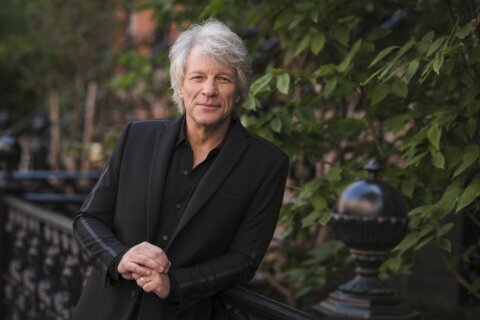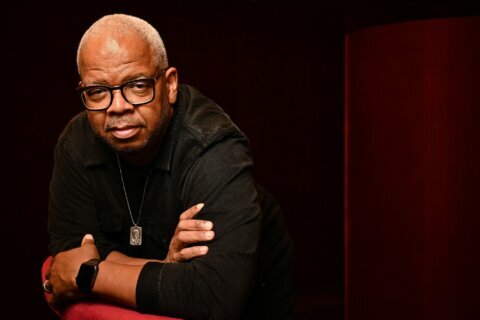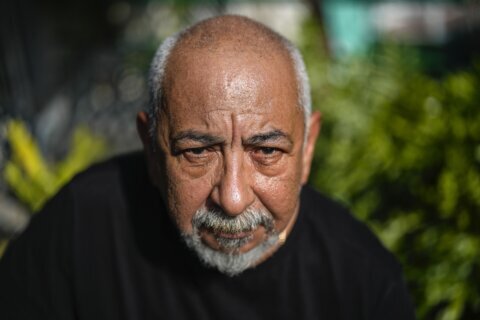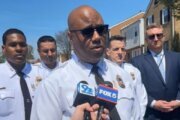You can call audibles at the line of scrimmage, but the snap count isn’t always audible.
That’s the theme tackled in the new Oscar-shortlisted documentary “Audible” now on Netflix, chronicling football at the Maryland School for the Deaf in Frederick, Maryland.
“I grew up about 30 minutes away,” director Matthew Ogens told WTOP. “My best friend since I was 7 years old is deaf, so I had a window into the deaf community and saw that there was not much deft storytelling … or it would be conventional ‘about’ and not ‘through’ characters. I wanted to tell a film not about, but with the Maryland School for the Deaf.”
Growing up in D.C., Potomac and Gaithersburg, he heard of the school’s winning streak.
“It took 12 years to get made and connect with Netflix with lots of stops and starts along the way,” Ogens said. “Coach Ryan, who is the head coach in the film, when I first connected with the school wanting to do a film, he was a player on the team. That’s how long the cycle was. … It happened when it happened. It happened at the perfect time.”
Aesthetically, Ogens shows players hitting the sled against sun rays, while using sound design like “Sound of Metal” or “CODA” to put viewers inside the deaf players’ cleats.
“I knew that I wanted to make sound a character in the film,” Ogens said. “It’s a film in some ways about sound and senses, so I wanted to convey to a hearing audience who could never know what it’s like to be deaf. … Also, vibrations. … Going for those bassier, lower, distorted sounds, so if someone who’s deaf turns up the volume, they might feel it.”
Revelatory details include flashing lights in the locker room to get pumped up for a game, hitting a gong on the sideline to start each play with vibrations, and the coach’s belief that deaf players hone their other senses to see the ball better than hearing students.
“It’s not a silent world,” Ogens said. “Go into that locker room before a game. It doesn’t sound so quiet. … I don’t look at them as great football players for being deaf; they’re really good football players who happen to be deaf. There’s a really big difference, proven by their record of playing both deaf and hearing schools for many, many years.”
Ironically, when Ogens finally showed up to film, the team lost its unbeaten streak.
“I showed up on the wrong day!” Ogens said. “No. 23 says, ‘This loss will not define us.’ That’s true literally, they come back to win, but it’s true of them in life. I don’t think of it as a football or sports film. That gives it its arc, its hook, but it’s one element in their life: school, family, relationships. … Football is just a great metaphor for the ups and downs of life.”
Founded in 1868, the Maryland School for the Deaf has two area campuses, recently celebrating its 100th anniversary in Frederick, while marking 50 years in Columbia this fall.
“We are a state-funded school,” Interim Chief Educational Programs Officer Jennifer Yost Ortiz told WTOP. “We’re free for all deaf and hard-of-hearing students throughout the state. They do not pay tuition. We are fully accredited and we serve students from birth to the age of 21. Right now we’re serving approximately 450 students from all over the state.”
The methods of instruction are just like hearing schools, but in a different language.
“American Sign Language is our language of instruction,” Ortiz said. “About 90% of our teaching faculty is deaf. We use a very rigorous curriculum, the same one used in public schools. Both campuses are nearby to Gallaudet University in D.C., so it’s a very deaf-friendly environment. That’s why we attract so many deaf and hard-of-hearing students.”
Ortiz’s sons play on the team: quarterback Zeke and running back Zion.
“Wait until you see her sons play!” Ogens said. “[Zion] score a lot of the touchdowns.”
Ogens had to recast numerous times over the past decade because the seniors kept graduating. Ultimately, his main character became senior Amaree McKenstry-Hall.
“I wanted to follow a senior because that cusp of graduating is a pivotal moment,” Ogens said. “Imagine if you’re deaf in this beautiful utopia [graduating] into a more exposed, hearing world. … He’s unique in that he was not born deaf; he got meningitis at age 3. Hopefully he represents the relatable experiences that other deaf teens go through.”
In just 40 minutes, the film captures an impressive mosaic of teammates and classmates.
“His relationship with Jalen [Perry], who is a cheerleader [shows] that confidence about being yourself applies to being deaf, not just being gay,” Ogens said. “Also, Teddy [Webster] is very much a catalyst. You can take great lessons out of tragedy.”
The experience was healing and educational for both the school and the film crew.
“They were willing to teach us a lot about the film industry,” Ortiz said. “Both groups worked really hard to minimize distractions … to spotlight our school and maintain a regular academic environment. … We didn’t realize all the nuances in creating a film, then at the end to sit back and watch, it’s a great way to reflect on all of the work we do.”
Filmed in 2019, the film also captured the last of pre-pandemic life.
“The following March was when we locked down for COVID,” Ortiz said. “When I watched it again recently I realized that was our last documentation of our pre-COVID dates. We haven’t had a homecoming dance since because of the pandemic … so that movie gave us a lot of memories and a lot to look forward to when we get back to that no-mask time.”
Area residents will also love seeing Downtown Frederick on display.
“Frederick is an amazing town,” Ortiz said. “Wherever I go, if it’s a cashier or somebody I’m interacting with, they at least know how to finger spell or they have interpreters at the ready. It’s just so deaf-friendly and so accommodating. The Frederick community is so focused on inclusivity and they always make sure that includes the deaf community.”
That community will be watching Tuesday to see if “Audible” is nominated for an Oscar.
“It’s very exciting,” Ogens said. “Of course, we’re going to do something. We’re still going to require social distancing of six feet, we’re still going to require masks and things, we will work out the logistics, but we’re definitely going to do something. We’re very excited.”
Win or lose, it’s an honor to be among the 15 short documentaries on the Oscar shortlist.
“This diverse group of filmmakers from around the world, shortlisted or not, they’re all important,” Ogens said. “I’m humbled to get this far. If it means elevating the deaf community and teaching people to listen about accessibility … that’s amazing to me.”
Here’s hoping “CODA” wins Best Picture, while “Audible” wins Best Documentary Short.
The new CODA (Child of Deaf Adults) might just be a Championship of Deaf Athletes.








